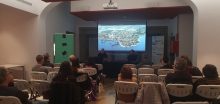-
Join the
Digital Meets Culture
Open Newsroom! If you have interesting news and events to point out in the field of digital cultural heritage, we are waiting for your contribution.
If you have interesting news and events to point out in the field of digital cultural heritage, we are waiting for your contribution.
-
Free text
-
-
Upcoming events
-
 Barcelona, December 9th and 10th, 2024
Barcelona, December 9th and 10th, 2024Join the annual EUscreen Symposium on December 9th and 10th in Barcelona. The rapid advancement of Artificial Intelligence technologies has opened new horizons for the audiovisual sector, offering opportunities for creativity, and efficiency. However, as AI becomes increasingly integrated … Continue reading →
 Girona and online, September 30, 2024
Girona and online, September 30, 2024Registrations are now open for the IV International Seminar on Sports Archives. The event will take place on September 30, 2024, both online and on-site at EspaiCaixa Girona – “la Caixa” Obra Social, Plaça Poeta Marquina, 10 (Girona). The biennial … Continue reading →
 The Summer School will be held in Zlarin, Croatia, on September 20-24, 2024
The Summer School will be held in Zlarin, Croatia, on September 20-24, 2024We are pleased to announce the Call for Applications for the IN SITU project Summer School “Place-based creative solutions for cultivating caring and sustainable communities”, to be held in the island of Zlarin, Croatia, on 20-24 September 2024. IN … Continue reading →










-
-
DIGITAL MEETS CULTURE IS MEDIA PARTNER OF: 
-
-
 Limassol (CY), 2nd December 2024 @ EuroMed2024
Limassol (CY), 2nd December 2024 @ EuroMed2024We are pleased to invite you to participate in a unique Workshop organised by the UNESCO Chair on Digital Cultural Heritage in cooperation with the EU Digital Europe EUreka3D Project, the Earth Observation Research Lab (EOCult), the Mechanical Engineering Design … Continue reading →
 Online
OnlineWe are delighted to announce the launch of Europeana Academy, the Europeana Foundation training programme for professionals working with, in and around cultural heritage. The Academy will support professionals in the sector to develop new skills and knowledge through a comprehensive … Continue reading →








